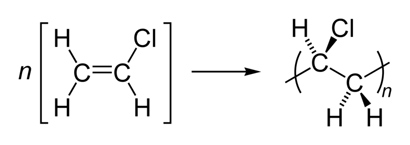Polyvinyl chloride, commonly abbreviated PVC, is a thermoplastic polymer. It is a vinyl polymer constructed of repeating vinyl groups having one hydrogen replaced by chloride. Polyvinyl chloride is the third most widely produced plastic, after polyethylene and polypropylene. PVC is widely used in construction because it is cheap, durable, and easy to assemble. PVC production is expected to exceed 40 million tons by 2016. According to IUPAC, polyvinyl chloride should be named poly (chloroethanediyl), but the name is not used.
It can be made softer and more flexible by the addition of plasticizers, the most widely used being phthalates. In this form, it is used in clothing and upholstery, electrical cable insulation, inflatable products and many other applications in which it would originally have replaced rubber.
| Polyvinyl chloride |
| Elongation at break |
20-40% |
| Notch test |
2-5 kJ/m2 |
| Glass temperature |
82 °C[1] |
| Melting point |
100–260 °C |
| Effective heat of combustion |
17.95 MJ/kg |
| Specific heat (c) |
0.9 kJ/(kg·K) |
| Water absorption (ASTM) |
0.04-0.4 |
Polyvinyl chloride is produced by polymerization of the vinyl chloride monomer (VCM), as shown.
The product of the polymerization process is unmodified PVC. Before PVC can be made into finished products, it almost always requires conversion into a compound by the incorporation of additives such as heat stabilizers, UV stabilizers, lubricants, plasticizers, processing aids, impact modifiers, thermal modifiers, fillers, flame retardants, biocides, blowing agents and smoke suppressors, and, optionally pigments.
The properties for PVC are usually categorized based on rigid and flexible PVCs.
| Property |
Rigid PVC |
Flexible PVC |
| Density [g/cm3] |
1.3–1.45 |
1.1–1.35 |
| Thermal conductivity [W/(m·K)] |
0.14–0.28 |
0.14–0.17 |
| Yield strength [MPa] |
31–60 |
10–25 |
| Young's modulus [psi] |
490,000 |
|
| Flexural strength (yield) [psi] |
10,500 |
|
| Compression strength [psi] |
9500 |
|
| Coefficient of thermal expansion (linear) [mm/(mm °C)] |
5×10−5 |
|
| Vicat B [°C] |
65–100 |
Not recommended |
| Resistivity [Ω m] |
1016 |
1012–1015 |
| Surface resistivity [Ω] |
1013–1014 |
1011–1012 |
While processing WPC PVC average content of PVC remains between 60 % - 70 % and balance portion remains wood waste and additives. WPC PVC is used for making water proof MDF boards, Hollow doors, Frames, Filler boards.
